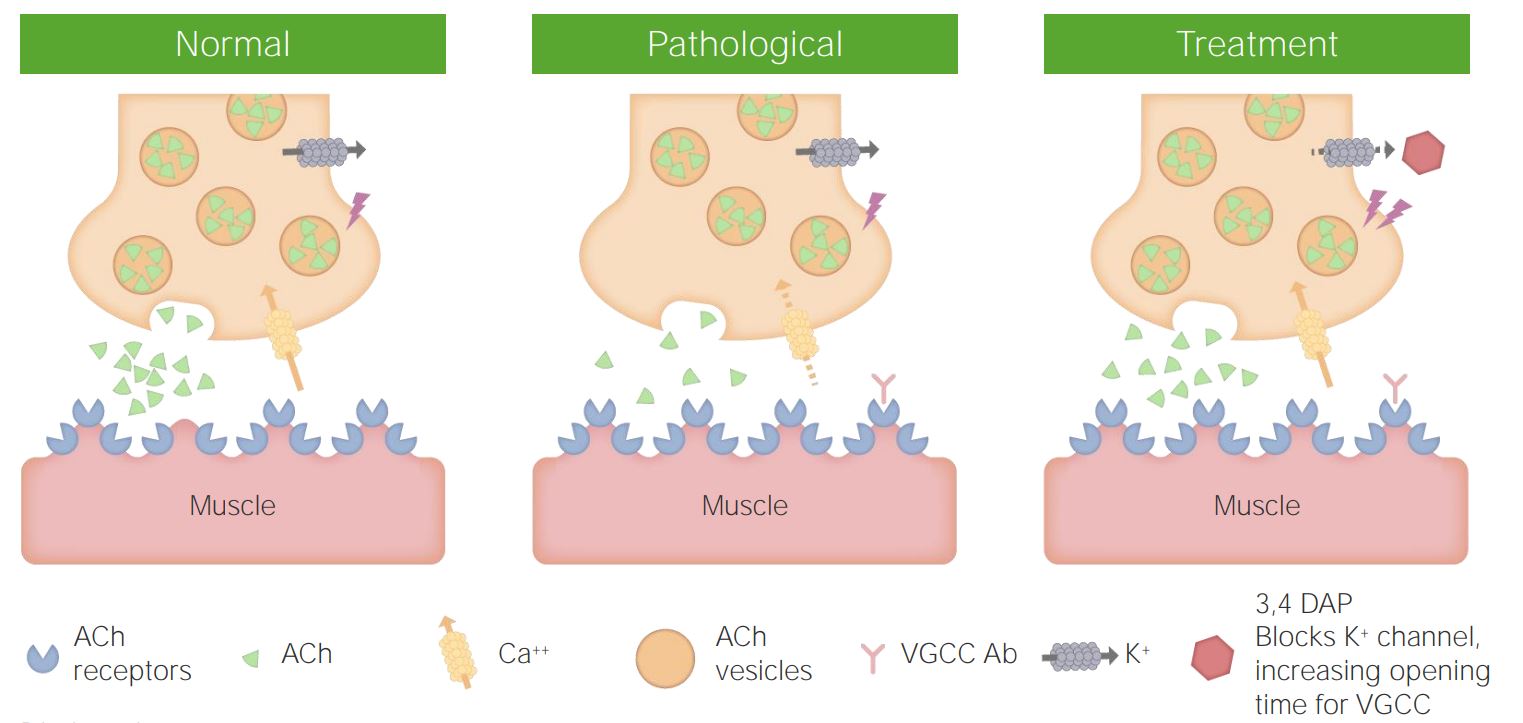Playlist
Show Playlist
Hide Playlist
Lambert Eaton Myasthenic Syndrome (LEMS): Pathophysiology and Treatment
-
Slides Strowd Neoplastic or Paraneoplastic NMJ Disorders.pdf
-
Download Lecture Overview
00:01 So let's look a little bit closer at the pathophysiology of Lambert-Eaton syndrome. 00:05 What's happening? What's going on at the level of the neuromuscular junction? Well, as we said, the condition is characterized by voltage-gated calcium channel antibodies. 00:14 These antibodies bind to that calcium channel on the presynaptic terminus and prevent calcium from coming into the terminus and allowing acetylcholine to be released into the synaptic cleft. 00:25 Reduced acetylcholine release leads to a decrement, a decrease in the baseline motor amplitude. 00:31 The baseline contraction of the muscle at that neuromuscular junction. 00:37 Quant chronic reduced acetylcholine quanta release results in increased postsynaptic folding. 00:43 So the neuromuscular junction recognizes that there's a problem and there's increased folding of the postsynaptic membrane. 00:51 With slow repetitive nerve stimulation, there's a decremental response. 00:55 And this is owing to the fact that there is a reduction in the amount of acetylcholine that's released into the synaptic cleft. 01:02 But with fast repetitive stimulation or 1 minute of forced maximal exercise, there's a build up of calcium that occurs in the presynaptic terminus. 01:12 You get a lot of calcium, you overwhelm those voltage gated calcium receptors are voltage-gated calcium channels. 01:19 And in this setting, there's increased postsynaptic folding and this results in an incremental response. 01:25 More acetylcholine is released into the cleft. 01:27 There is more postsynaptic folding and more acetylcholine receptors and this results in increased response. 01:34 Let's look at that pictorially in this graph here. 01:37 So here we see normal transmission. 01:39 There's an action potential that activates the voltage-gated calcium channels in the presynaptic terminus. 01:45 Calcium is in flux into the terminus, this allows the vesicles containing acetylcholine to be, bind to the presynaptic membrane. 01:53 Acetylcholine is released, and there's activation of the muscle What happens in the pathologic state? In the pathologic state, there's still an action potential but those voltage-gated calcium channels can be activated. 02:05 There's antibodies binding preventing calcium from in fluxing into the nerve terminus, and as a result, you see less acetylcholine released and less muscle activation and contraction. 02:16 What about with treatment? We're going to talk in the next slide about some of the treatments for this condition, and 1 is this agent called 3,4-Diaminopyridine. 02:27 And this is a drug that acts on the presynaptic terminus to prolong the time of calcium influx. 02:34 And so even though there's less influx with each action potential it prolongs the time of in flux increases the amount of vesicles that bind the presynaptic terminus and you get more acetylcholine in the cleft and more likely see muscle contraction and end-plate depolarization. 02:51 So what are the treatments for Lambert-Eaton myasthenic syndrome? Well, we've tried a number of things. 02:55 Corticosteroids can be used to reduce the amount of circulating immune cells. 02:59 Those voltage-gated calcium channel antibodies that we see. 03:02 Guanidine has been tested, 3,4-Diaminopyridine is a neat medicine that is approved and used for the treatment of this condition. 03:11 It acts on potassium channels in the presynaptic terminus. 03:14 It prolongs the time of calcium channel in flux in the presynaptic terminus, increases the likelihood that those synaptic vesicles will bind to the membrane and release their acetylcholine quanta. 03:26 And so it can improve muscle contraction and connection at the neuromuscular junction. 03:32 This is also an immune mediated condition and so Plasmapheresis and intravenous immunoglobulin can be used to remove those antibodies from systemic circulation and improve patients symptoms. 03:43 In addition, this is associated with cancer and it occurs as a result of the immune response to the cancer. 03:50 Treatment of cancer is critical. 03:53 When the cancer is treated and put into remission, the immune response dies down in many patients see improvement in their symptoms.
About the Lecture
The lecture Lambert Eaton Myasthenic Syndrome (LEMS): Pathophysiology and Treatment by Roy Strowd, MD is from the course Disorders of the Neuromuscular Junctions.
Included Quiz Questions
Which of the following is not consistent with the pathophysiology of Lambert-Eaton myasthenic syndrome?
- Slow, repetitive nerve stimulation results in increased response due to a calcium build-up in the presynaptic terminus.
- Voltage-gated calcium channel antibodies prevent calcium influx into the presynaptic terminus.
- Reduced acetylcholine (ACh) release results in a decrease in baseline motor amplitude.
- Slow, repetitive nerve stimulation results in diminished response due to a reduction in ACh release.
- Fast repetitive nerve stimulation increases the buildup of calcium in the presynaptic terminus resulting in an incremental response.
Which of the following is not a treatment for Lambert-Eaton myasthenic syndrome?
- Pyridostigmine
- Corticosteroids
- 3,4-diaminopyridine
- Plasmapheresis
- Immunosuppression
Customer reviews
5,0 of 5 stars
| 5 Stars |
|
5 |
| 4 Stars |
|
0 |
| 3 Stars |
|
0 |
| 2 Stars |
|
0 |
| 1 Star |
|
0 |




